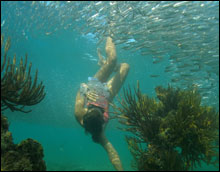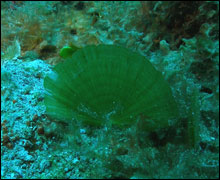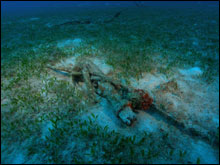Error processing SSI file
|
Mission Blog: Sept. 28, 2009
Chelsea Lowes, Onboard Cruise Log Coordinator
Knauss Sea Grant Fellow, NOAA Ecosystem Research Program
 |
| Snorkeler looking up through schooling fish. (Photo: NOAA CCFHR) |
Chief Scientist John Burke and divemaster Jenny Vander Pluym gave the scientists a much needed and thoroughly earned morning off today. And what do scientists do on their break from diving and looking at coral and fish? They go snorkeling to look at coral and fish, of course!
But fish are not the only exciting organisms that we come across. Read on for a little insight from Christine Addison and Abby Poray on two very important primary producers in the ocean: seagrasses and macroalgae.
. . . . . . . . . . .
Christine Addison, Research Technician
NCCOS Center for Coastal Fisheries and Habitat Research
Abigail Poray, Graduate Student
California State University, Northridge
Marine communities are dependent on a set of primary producers, or plant-like individuals, that make up the base of the food chain. Macroalgae and seagrasses are important flora in the ocean.
 |
| Green alga Udotea flabelum anchored in sand plain. (Photo: NOAA CCFHR) |
Macroalgae, also known as "seaweed", comes in many shapes and sizes - from mat-like tuffs of hair to upright, intricately branching individuals extending into the water column. They occupy open sand plains as well as available rocky surfaces on coral reefs, where they are often in competition with corals for space. Such competitive interactions between corals and macroalgae are often kept in check by grazing fish or invertebrates feeding on the faster growing algae. Long-term reef surveys, such as those conducted during this research expedition, allow us to monitor changes in abundances between coral and macroalgae with shifts in environmental conditions.
Seagrasses are flowering plants, much like the grass in your yard. They are food for turtles, manatees, and a variety of fishes. By providing protection from predators, seagrasses are a valuable nursery habitat for many organisms, including economically important species such as shrimp, lobster, and snapper. Seagrasses improve water clarity and stabilize sediments by trapping particles, in much the same way that the grass in your yard reduces erosion.
 |
| Meadow of Halophila seagrass. (Photo: NOAA CCFHR) |
Within the Tortugas region there are three main seagrass species. Two are found on sand plains in the shallow waters of the Dry Tortugas National Park and a third, smaller species, is found in waters up to 110 feet deep. Our research divers encounter this deeper water species, Halophila decipiens, at a number of the permanent sites. Halophila, along with the algae occurring on the reef and sand interface, are important food sources for the foraging fish and invertebrates within the deeper portions of the Tortugas Banks.
|



